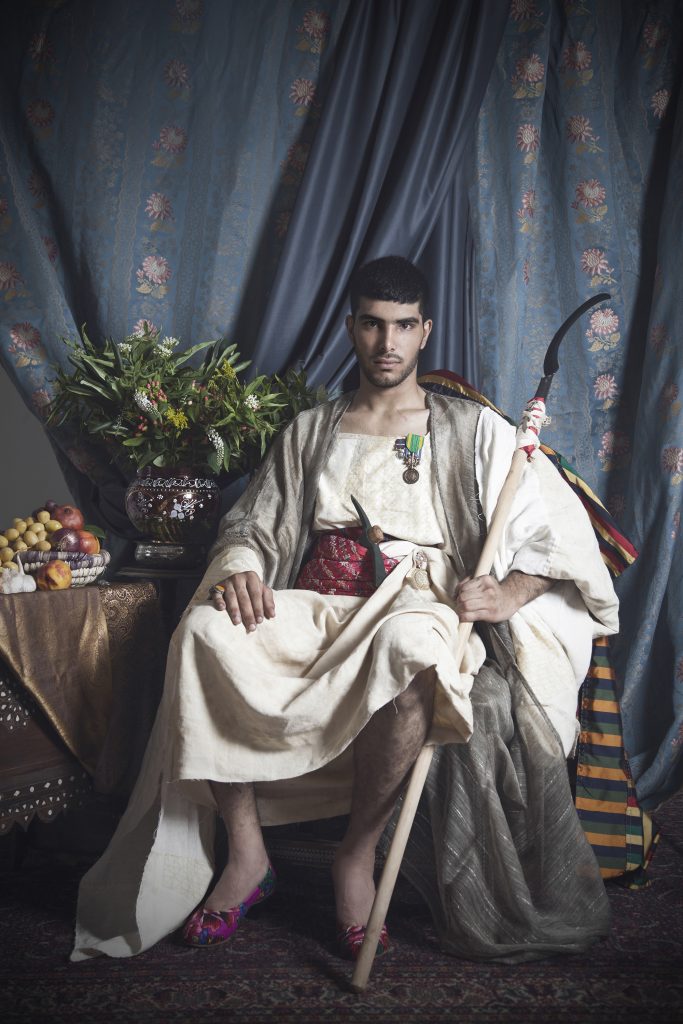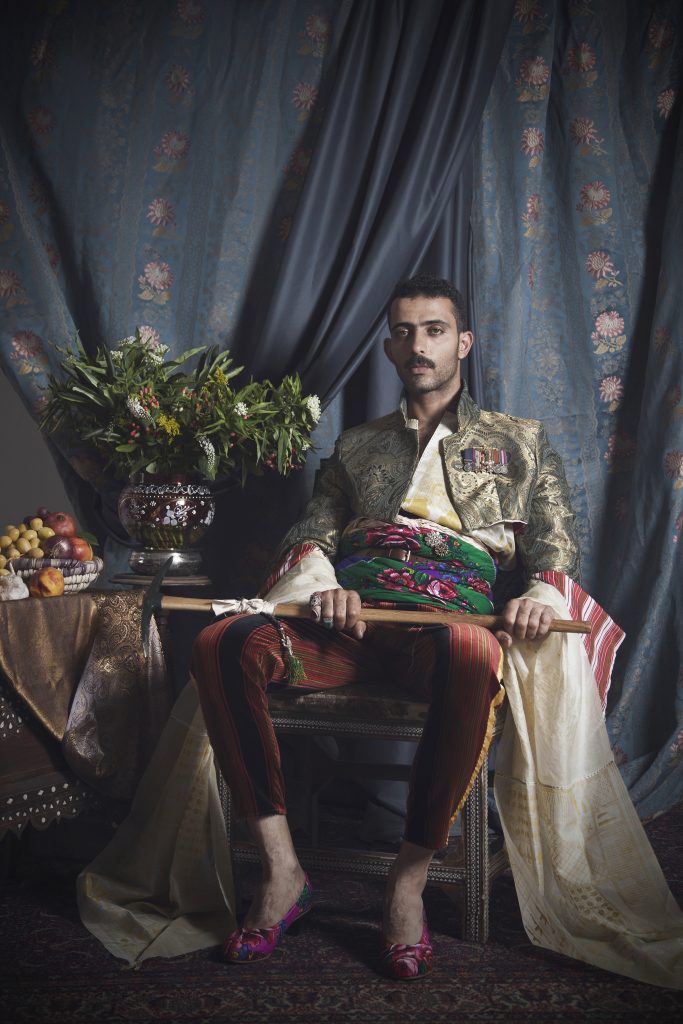 Detail, Stvdio El Sham, Joe © Omarivs Ioseph Filivs Dinæ and Tarek Moukaddem
Detail, Stvdio El Sham, Joe © Omarivs Ioseph Filivs Dinæ and Tarek Moukaddem
“The portrait photograph is a two-sided performance, one having to do with the photographer who manipulates technology, models, props and backgrounds behind the camera, and the other with the model who performs self especially and uniquely for the camera”
Conventional wisdom situates the advent of portrait photography in the Arab world inside a larger historiographic framework during which the disseminators of colonial discourse sought to create visual material capable of presenting the perceived Oriental subject to a Western gaze. These grand narratives, however crucial for a collective understanding of Orientalism as a process of othering, tend to efface some early practices of photographic portraiture by Arab inhabitants of the Ottoman Empire which existed not as reaction to colonialist image production but, according to Stephen Sheehi, simply as “a social practice, a technological act, an ideological enactment, and a condensation of shifts in political economy that express as well as displace the history of the contexts of its production.” It is within this tradition of indigenous Arab portrait photography which maintained signifiers of cultural difference such as vernacular dress while allowing its models to exercise some form of self-representation that the likes of the Abdullah Freres and Pascal Sebah became widely known and celebrated in the Ottoman Arab world, paving the way for a practice that has persisted throughout a century struck by an enormous profusion of ideologies, tragedies, and technological advancements.

Stvdio El Sham, Abu Zuhair, The Official Portrait © Omarivs Ioseph Filivs Dinæ and Tarek Moukaddem
The collaboration between Lebanese photographer Tarek Moukaddem and Palestinian fashion designer Omarivs Ioseph Filivs Dinæ’s seems to have picked photographic portraiture up right where early 20th century Arab practitioners had left off. It consists of artistic studio portrait photography constructed around fashion items that question dress as a tool and marker of power and identity in an Arab context, in addition to re-examining local historical processes of image production. While there is no denying the status of photographic portraiture as a constitutive feature of modernity, the singular portrait, especially in its studio variation, occupies a much less paradigmatic space in the age of the online “hemorrhaging” of the self-portrait, in the words of Dinæ. Still, lazily assuming that Dinæ and Moukaddem’s interest in archaic instances of photographic portraiture is due merely to a fascination with pastiche will overlook both their intention and the medium’s more complex offerings. In practice, the work goes beyond the facile romanticization of past epochs and their attendant customs and aesthetics to examine the ever-evolving dynamics between photographer, model, and prop.
The Official Portrait, the final iteration of a broader project titled The Ceremonial Vniform, aims to respond, rather cynically, to the Palestinian National Authority (PNA)’s unsuccessful application for full United Nations membership in 2011, and its subsequent accepting of the non-member observer state status for Palestine in the General Assembly, by seeking to ridicule state-based imaginaries. Dinæ and Moukaddem’s exercise stems from envisaging portraits of statesmen ruling over a fictional Palestinian nation which has cast aside collective emancipation in favor of normative values of statehood.

Stvdio El Sham, Abu Saleh, The Official Portrait © Omarivs Ioseph Filivs Dinæ & Tarek Moukaddem
Indeed, in an effort to subvert the traditional invocation of the figure of the indigenous male worker in state-sanctioned representations, the seated male models, themselves actual manual laborers with no prior modeling experience, are dressed in pieces inspired by Islamic talismanic shirts and inscribed with excerpts of speeches by Palestinian political leader Yasser Arafat. Most striking in the composition is the decision to dress the models in women’s shoes. Omarivs is quick to point out that this is not at all in a bid to “emasculate” the male figure, but rather to critique the persistent and formidable intertwining of masculinity and nationalism. The portrait takes place against a backdrop that is decidedly European in its references, seemingly a bastard hybrid between a Flemish still-life painting and an interior from a royalty portrait. One could argue that the decision to superpose Arab dress on European background is rooted in a will to expose Oriental images of indigeneity as always already deriving from Western visual representations, but what could also be felt is a subtler, more radical, commentary on the demand for a Palestinian nation-state which in itself is deeply entrenched in Western political structures.
Stvdio el Sham, on the other hand, is presented by the duo as an “ongoing experiment” rather than a project. What helps make sense of the playful use of objects, attire, and staging in Stvdio el Sham portraits is situating them as a reflection on practices in early commercial photographic portraiture. If the performance of identity involves the lived repetition of performative acts, then the identity-forming power of portrait photography lies in its recording and making-permanent of those performative acts. In the early days of commercial portraiture, the photographic act took place rarely and did not attempt to record that repetition. It had to compensate by relying heavily on acts, postures, and garments that condensed lifetimes and social positions and relationships efficiently into millimeters of film. As can be seen in the oeuvre of Hashem el-Madani, a main reference for Stvdio el Sham and a visual corpus that has been widely visited by artists and theorists of the image, friendships and kinship are immortalized as kisses on cheeks or warm hand-holding. In this light, the studio photograph of that period and its contents attain weight as a media of self-representation that goes far beyond that of any photo produced currently.

Stvdio El Sham, Joe © Omarivs Ioseph Filivs Dinæ and Tarek Moukaddem
It is precisely this weight that informs the duo’s artistic processes throughout different installments of their collaboration. In Official Portraits, the targeted photographic practice is one that is employed by the state to represent its figureheads to the general populace. Consequently, the staging of the photographs takes place independently of the models’ desires to represent themselves: the photographers have dictated the backdrop, dress, and posture of the photographic subject. In Stvdio el Sham, the complete opposite takes place. As a mirroring of the wide margin for self-representation traditionally present in studio portraiture, the photographers merely provided the models with a collection of objects and fashion items, retreating in order to avoid hindering the model’s agency. The resulting characters are crafted by the models themselves, who self-curate within a gamut set by the photographer-designer couple.
Whether to ridicule nationalist enterprises of meaning-production or capture how subjectivity may be constituted through embodied performance, Dinæ and Moukaddem have proven that portrait photography, even in its most traditional incarnations, is worthy of study and celebration in an epoch of instantaneity, holding still the faculty to inform, critique, and poeticize.